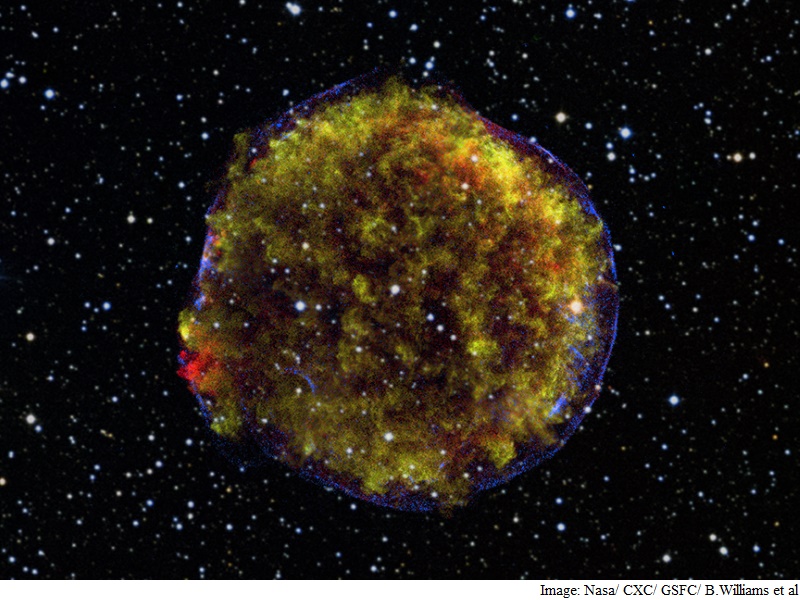- Home
- Science
- Science News
- Chandra Assisted Movie Recreates Stellar Explosion Observed in 1572
Chandra-Assisted Movie Recreates Stellar Explosion Observed in 1572

It shows that the expansion from the explosion - now known as Tycho's supernova remnant - is still continuing about 450 years later as seen from Earth's vantage point roughly 10,000 light years away.
A Danish astronomer, Tycho Brahe, wrote a book about his extensive observations of the event, gaining the honour of the explosion being named after him.
The Tycho remnant was created by the explosion of a white dwarf star, making it part of the so-called "Type Ia" class of supernovas used to track the expansion of the universe.
By combining the X-ray data with some 30 years of observations in radio waves, astronomers produced a movie, using three different images.
The researchers measured the speed of the blast wave at many different locations around the remnant.
The large size of the remnant enables this motion to be measured with relatively high precision.
Although the remnant is approximately circular, there are clear differences in the speed of the blast wave in different regions.
"The speed in the right and lower right directions is about twice as large as that in the left and the upper left directions. This difference was also seen in earlier observations," Nasa said in a statement.
This range in speed of the blast wave's outward motion is caused by differences in the density of gas surrounding the supernova remnant.
This causes an offset in position of the explosion site from the geometric center, determined by locating the centre of the circular remnant.
The astronomers found that the size of the offset is about 10 percent of the remnant's current radius, towards the upper left of the geometric centre.
The team also found that the maximum speed of the blast wave is about 12 million miles per hour.
A paper describing these results has been accepted for publication in The Astrophysical Journal Letters.
Get your daily dose of tech news, reviews, and insights, in under 80 characters on Gadgets 360 Turbo. Connect with fellow tech lovers on our Forum. Follow us on X, Facebook, WhatsApp, Threads and Google News for instant updates. Catch all the action on our YouTube channel.
Related Stories
- Samsung Galaxy Unpacked 2025
- ChatGPT
- Redmi Note 14 Pro+
- iPhone 16
- Apple Vision Pro
- Oneplus 12
- OnePlus Nord CE 3 Lite 5G
- iPhone 13
- Xiaomi 14 Pro
- Oppo Find N3
- Tecno Spark Go (2023)
- Realme V30
- Best Phones Under 25000
- Samsung Galaxy S24 Series
- Cryptocurrency
- iQoo 12
- Samsung Galaxy S24 Ultra
- Giottus
- Samsung Galaxy Z Flip 5
- Apple 'Scary Fast'
- Housefull 5
- GoPro Hero 12 Black Review
- Invincible Season 2
- JioGlass
- HD Ready TV
- Laptop Under 50000
- Smartwatch Under 10000
- Latest Mobile Phones
- Compare Phones
- Honor Win RT
- Honor Win
- Xiaomi 17 Ultra Leica Edition
- Xiaomi 17 Ultra
- Huawei Nova 15
- Huawei Nova 15 Pro
- Huawei Nova 15 Ultra
- OnePlus 15R
- Asus ProArt P16
- MacBook Pro 14-inch (M5, 2025)
- OPPO Pad Air 5
- Huawei MatePad 11.5 (2026)
- Xiaomi Watch 5
- Huawei Watch 10th Anniversary Edition
- Acerpure Nitro Z Series 100-inch QLED TV
- Samsung 43 Inch LED Ultra HD (4K) Smart TV (UA43UE81AFULXL)
- Asus ROG Ally
- Nintendo Switch Lite
- Haier 1.6 Ton 5 Star Inverter Split AC (HSU19G-MZAID5BN-INV)
- Haier 1.6 Ton 5 Star Inverter Split AC (HSU19G-MZAIM5BN-INV)

















